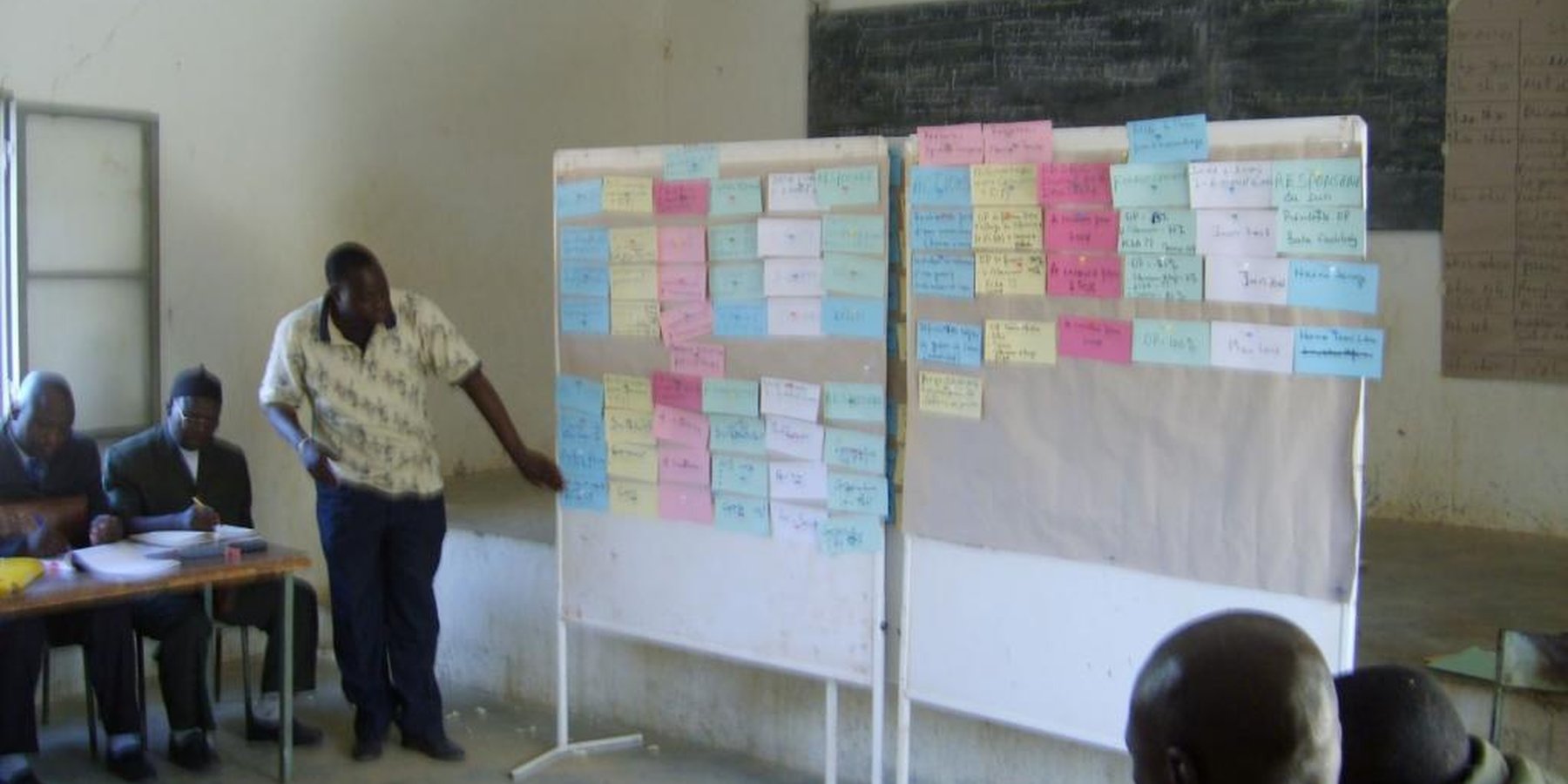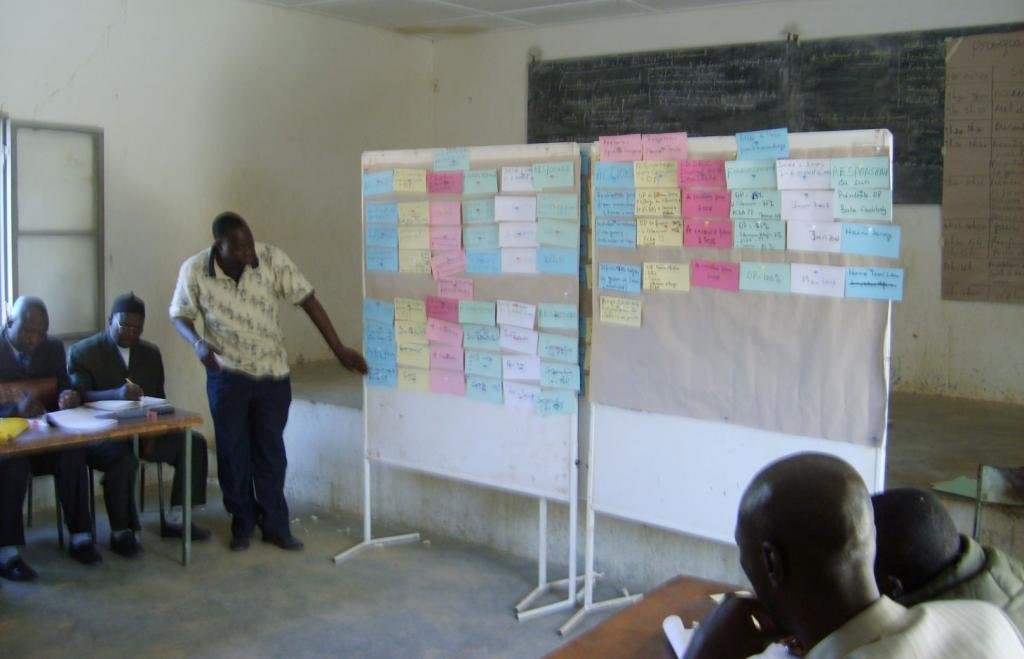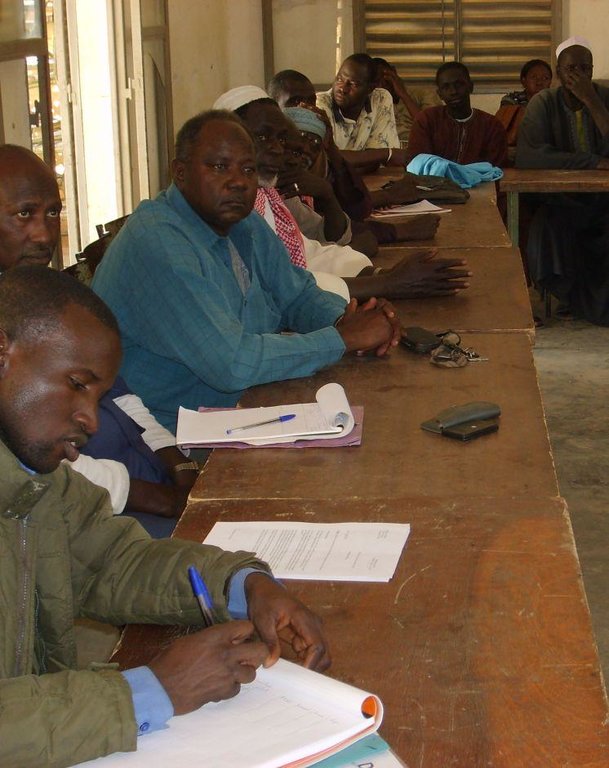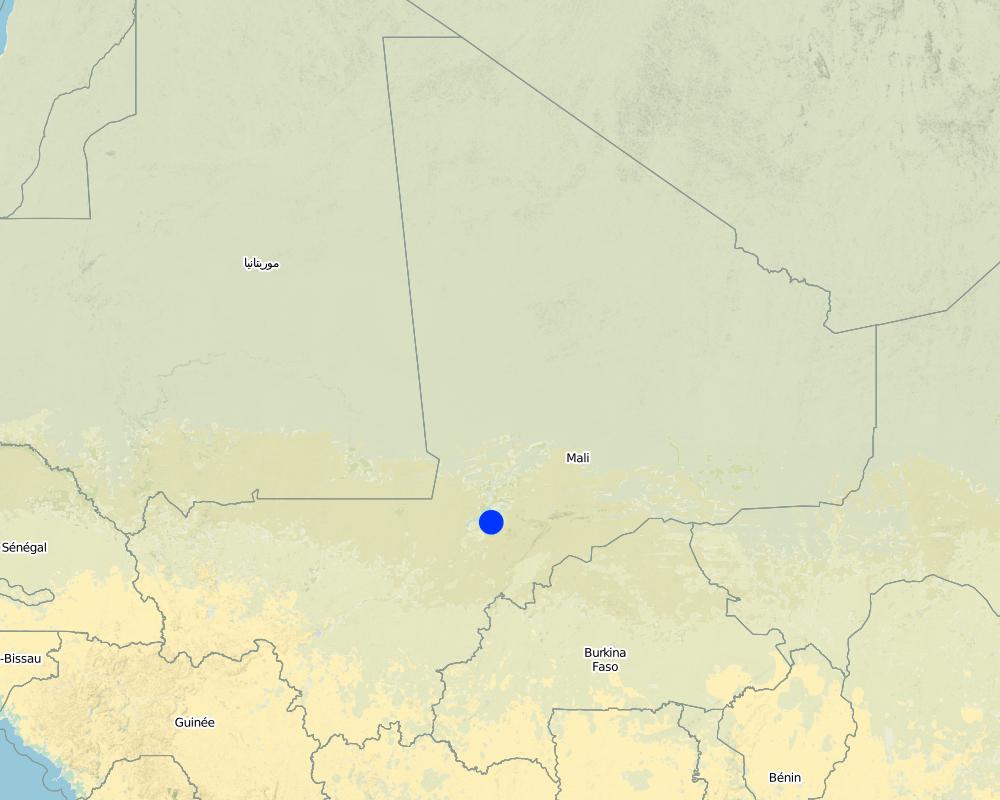Establishment and support of coordination platforms for commune and private sector collaboration [Mali]
- Creación:
- Actualización:
- Compilador: Dieter Nill
- Editor: –
- Revisor: Laura Ebneter
Mise en place et accompagnement des cadres de concertation entre la commune et le secteur prive
approaches_2512 - Mali
Visualizar secciones
Expandir todo Colapsar todos1. Información general
1.2 Detalles de contacto de las personas de referencia e instituciones involucradas en la evaluación y la documentación del Enfoque
Especialista MST:
Cisse Dieneba
dieneba.cisse@giz-pact.org
Deutsche Gesellschaft für Internationale Zusammenarbeit (GIZ)
Mali
Nombre del proyecto que facilitó la documentación/ evaluación del Enfoque (si fuera relevante)
Programme for Territorial Communities, Mali (PACT)Nombre de la(s) institución(es) que facilitaron la documentación/ evaluación del Enfoque si fuera relevante)
Deutsche Gesellschaft für Internationale Zusammenarbeit (GIZ) GmbH (GIZ) - Alemania1.3 Condiciones referidas al uso de datos documentados mediante WOCAT
¿Cuándo se compilaron los datos (en el campo)?
01/07/2012
El compilador y la/s persona(s) de referencia claves aceptan las condiciones acerca del uso de los datos documentados mediante WOCAT :
Sí
2. Descripción del Enfoque MST
2.1 Breve descripción del Enfoque
Facilitate dialogue between commune representatives and sector players in order to direct investments and commune services towards the real needs of professionals.
2.2 Descripción detallada del Enfoque MST
Descripción detallada del Enfoque MST:
Consultation frameworks aim to facilitate dialogue between commune representatives and sector players in order to direct investments and commune services towards the real needs of professionals in the sectors in question.
The approach involves instituting a consultation framework for local authority actors and professionals from economic sectors in order to identify these economic actors’ needs vis-à-vis community investments, to factor these needs into local and regional authority planning, and to promote trust and collaboration between actors.
The commune identifies two or three high-growth sectors that are a priority for the commune and also identifies the actors (groups, cooperatives, associations) operating in these sectors. It then puts a consultation framework in place that brings together the municipality, sector actors, local technical services, representatives from technical and funding partners, and NGOs appropriate to or operating in the sectors in question. The decision to establish a framework is made on the back of commune council deliberations. Prior to the first consultation framework meeting, sector professionals identify their needs in terms of investments and measures to improve the business environment. During these periodic meetings, attendees negotiate and agree on priority actions and write these up in a very short-term (three-month) action plan. The consultation framework group then moves to install an inclusive monitoring committee to oversee the implementation of the action plan. The committee’s mandate is defined and evolves in accordance with the results that are achieved over time and with new needs arising. The successive nature of the consultation framework meetings means that progress can be measured, required adjustments made and new activities programmed to move the sectors forward.
PACT provides technical support (methods and tools for work, moderation and training) and contributes financially to consultation workshops. The commune formalises the framework, organises the logistics of meetings (invites, meeting rooms, chair hire, accommodation), contributes to implementing the action plan (registering its designated actions with PDESC, financing), provides incentives (supporting the training of cooperatives; land access; linking up actors; acting as intermediary in negotiations among cooperatives, technical and financial partners and NGOs). Professional organisations mobilise and train their members, cover the costs of their designated activities (radio reports, member travel arrangements, opening accounts, etc.), identify and negotiate within each individual profession the required actions for inclusion in the action plan, and contribute to the cost of building infrastructure. Technical services provide technical support to the two main parties (municipality and professional organisations). The monitoring committee helps ensure the action plan is implemented on schedule, identifies obstacles to implementation and communicates these to consultation framework actors so they can find solutions and move forward with a new action plan.
2.3 Fotos del Enfoque
2.5 País/ región/ lugares donde el Enfoque fue aplicado
País:
Mali
Región/ Estado/ Provincia:
Mali
Especifique más el lugar :
regions of Ségou and Koulikoro
Map
×2.6 Fechas de inicio y conclusión del Enfoque
Indique año del inicio:
2007
2.7 Tipo de Enfoque
- proyecto/ basado en un programa
2.8 Propósitos/ objetivos principales del Enfoque
Consultation frameworks aim to facilitate dialogue between commune representatives and sector players in order to direct investments and commune services towards the real needs of professionals in the sectors in question.
The SLM Approach addressed the following problems: lack of dialogue between commune representatives and sector players
2.9 Condiciones que facilitan o impiden la implementación de la/s Tecnología/s aplicadas bajo el Enfoque
entorno institucional
- impiden
lack of dialogue between commune representatives and sector players
Treatment through the SLM Approach: instituting a consultation framework for local authority actors and professionals from economic sectors in order to identify economic actors’ needs and to factor these needs into local and regional authority planning, to promote trust and collaboration between actors.
3. Participación y roles de las partes interesadas involucradas
3.1 Partes interesadas involucradas en el Enfoque y sus roles
- usuarios locales de tierras/ comunidades locales
- especialistas MST/consejeros agrícolas
- gobierno local
- gobierno nacional (planificadores, autoridades)
- organización internacional
3.2 Involucramiento de los usuarios locales de tierras/ comunidades locales en las distintas fases del Enfoque
| Involucramiento de los usuarios locales de tierras/ comunidades locales | Especifique quién se involucró y describa las actividades | |
|---|---|---|
| iniciación/ motivación | pasivo | |
| planificación | interactivo | |
| implementación | interactivo | |
| monitoreo y evaluación | interactivo | The monitoring committee helps ensure the action plan is implemented on schedule, identifies obstacles to implementation and communicates these to consultation framework actors so they can find solutions and move forward with a new action plan |
| Research | pasivo |
3.4 La toma de decisiones en la selección de Tecnología(s) MST
Especifique quién decidió la selección de las Tecnología/ Tecnologías a implementarse:
- principalmente por especialistas MST en consulta con usuarios de tierras
Explique:
Decisions on the method of implementing the SLM Technology were made by mainly by SLM specialists with consultation of land users
4. Apoyo técnico, fortalecimiento institucional y gestión del conocimiento
4.1 Construcción de capacidades / capacitación
¿Se proporcionó la capacitación a usuarios de tierras/ otras partes interesadas?
Sí
Especifique quién fue capacitado:
- usuarios de tierras
Si fuese relevante, también especifique género, edad, estatus, etnicidad, etc.
Training provided/supported by PACT, the commune, professional organisations
Forma de capacitación:
- reuniones públicas
4.2 Servicio de asesoría
¿Los usuarios de tierras tienen acceso a un servicio de asesoría?
Sí
Describa/ comentarios:
Name of method used for advisory service: technical support (methods and tools for work, moderation and training), financial contribution
4.3 Fortalecimiento institucional (desarrollo institucional)
¿Se establecieron o fortalecieron instituciones mediante el Enfoque?
- sí, mucho
Especifique el nivel o los niveles en los que se fortalecieron o establecieron las instituciones:
- local
Especifique el tipo de apoyo:
- financiero
- construcción de capacidades/ entrenamiento
- equipo
4.4 Monitoreo y evaluación
¿El monitoreo y la evaluación forman parte del Enfoque?
Sí
Comentarios:
socio-cultural aspects were ad hoc monitored by project staff, land users through observations
economic / production aspects were regular monitored by project staff, land users through measurements
management of Approach aspects were ad hoc monitored by project staff through observations
There were no changes in the Approach as a result of monitoring and evaluation
There were no changes in the Technology as a result of monitoring and evaluation
4.5 Investigación
¿La investigación formó parte del Enfoque?
Sí
Especifique los temas:
- sociología
- economía/ marketing
5. Financiamiento y apoyo material externo
5.1 Presupuesto anual para el componente MST del Enfoque
Comentarios (ej. fuentes principales de financiamiento/ donantes principales):
Approach costs were met by the following donors: international: 100.0%
5.2 Apoyo financiero/material proporcionado a los usuarios de tierras
¿Los usuarios de tierras recibieron financiamiento/ apoyo material para implementar la Tecnología/ Tecnologías? :
Sí
Si respondió sí, especifique el tipo o los tipos de apoyo, condiciones y proveedor(es) :
The beneficiaries (municipality and professional organisations) contribute to covering the costs involved. It is a win-win process for the municipality and professional organisations and the costs involved are low. Progress can potentially be restricted by the low-levels of resources that both the territorial communities (rural communes) and local economic actors can invest in infrastructure and the fact that PACT cannot make capital investments. This lack of investment can sap the desire of actors to continue with the consultation process.
5.3 Subsidios para insumos específicos (incluyendo mano de obra)
- equipo
| Especifique qué insumos se subsidiaron | En qué grado | Especifique los subsidios |
|---|---|---|
| maquinaria | totalmente financiado | |
| herramientas | totalmente financiado | |
Si la mano de obra de usuarios de tierras fue un insumo sustancial, ¿fue:
- recompensado con otro tipo de apoyo material?
5.4 Crédito
¿Se proporcionó crédito bajo el Enfoque para actividades MST?
No
6. Análisis de impacto y comentarios de conclusión
6.1 Impactos del Enfoque
¿El Enfoque ayudó a los usuarios de tierras a implementar y mantener Tecnologías MST?
- No
- Sí, un poco
- Sí, moderadamente
- Sí, mucho
consultation framework brings together the municipality, sector actors, local technical services, representatives from technical and funding partners, and NGOs; Commune water-use planning that takes into account commercial (e.g., small-scale irrigation schemes) as well as drinking water purposes
¿El Enfoque empoderó a grupos en desventaja social y económica?
- No
- Sí, un poco
- Sí, moderadamente
- Sí, mucho
Did other land users / projects adopt the Approach?
- No
- Sí, un poco
- Sí, moderadamente
- Sí, mucho
Ségou Region: Ségou Circle (communes of Dioro, Sansanding, Togou, Markala and Farakou Massa) and Macina Circle (communes of Boky-Wèrè, Kokry, Souleye, Saloba and Kolongo) Implementation locations: Koulikoro Region: Koulikoro Circle (communes of Sirakorala, Koula Togouni, Nyamina and Doumba) and Kati Circle (communes of Ouélessébougou, Dialakoroba, Sanankoroba, Dio-Gare and Yélékébougou). The approach has been applied in 20 communes in two regions and four circles. On average, each commune has two cooperatives, which are professional organisations representing between 60 and 120 members.
Did the Approach lead to improved livelihoods / human well-being?
- No
- Sí, un poco
- Sí, moderadamente
- Sí, mucho
trust and collaboration between actors; consultation framework brings together the municipality, sector actors, local technical services, representatives from technical and funding partners, and NGOs
Did the Approach help to alleviate poverty?
- No
- Sí, un poco
- Sí, moderadamente
- Sí, mucho
6.2 Motivación principal del usuario de la tierra para implementar MST
- producción incrementada
- incremento de la renta(bilidad), proporción mejorada de costo-beneficio
- pagos/ subsidios
6.3 Sostenibilidad de las actividades del Enfoque
¿Pueden los usuarios de tierras sostener lo que se implementó mediante el Enfoque (sin apoyo externo)?
- incierto
Si respondió no o incierto, especifique y comente:
The most important factor in ensuring success is a willingness to collaborate on the part of the municipality (whose revenue is based on taxes paid by economic actors) and economic actors who have expectations with regard to the installation of infrastructure/community facilities for trade and to business opportunities that the municipality can facilitate. Levels of success are strongly linked to the support provided to the two main actors, namely:
1) training and support for the municipality in managing the local development, mobilising resources, and negotiating and developing partnerships;
2) training and support for economic actors in formalising the cooperative or company, mobilising and securing financial resources, setting up and managing projects, and negotiating and implementing partnerships.
6.4 Fortalezas/ ventajas del Enfoque
| Fuerzas/ ventajas/ oportunidades desde la perspectiva del compilador o de otra persona de referencia clave |
|---|
| The beneficiaries (municipality and professional organisations) contribute to covering the costs involved. It is a win-win process for the municipality and professional organisations and the costs involved are low. |
|
Formalisation of professional organisations and steering of these towards economic goals. Increased awareness in the municipality of the need to include economic factors in planning |
|
Commune water-use planning that takes into account commercial (e.g., small-scale irrigation schemes) as well as drinking water purposes |
|
collaborative relationship between the municipality and private sector (better mutual understanding of local authority and professional sector actors) |
| embedding of community structural investments in community planning |
| Greater willingness to pay taxes |
| creation of new funding streams for local authorities |
| empowerment of private sector actors in terms of investments |
| Improved basic community services for actors operating in sectors related to small-scale irrigation |
| Joint identification of needs (investments and capacity building of actors). |
6.5 Debilidades/ desventajas del Enfoque y formas de sobreponerse a ellos
| Debilidades/ desventajas/ riesgos desde la perspectiva del compilador o de otra persona de referencia clave | ¿Cómo sobreponerse a ellas? |
|---|---|
| Progress can potentially be restricted by the low-levels of resources that both the territorial communities (rural communes) and local economic actors can invest in infrastructure and the fact that PACT cannot make capital investments. This lack of investment can sap the desire of actors to continue with the consultation process. |
7. Referencias y vínculos
7.1 Métodos/ fuentes de información
- visitas de campo, encuestas de campo
- entrevistas con usuarios de tierras
7.2 Referencias a publicaciones disponibles
Título, autor, año, ISBN:
Manual of Good Practices in Small Scale Irrigation in the Sahel. Experiences from Mali. Published by GIZ in 2014.
¿Dónde se halla disponible? ¿Costo?
http://star-www.giz.de/starweb/giz/pub/servlet.starweb
Vínculos y módulos
Expandir todo Colapsar todosVínculos
No hay vínculos
Módulos
No se hallaron módulos





